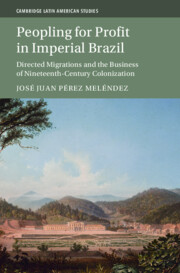 Peopling for Profit in Imperial Brazil
Peopling for Profit in Imperial Brazil Book contents
- Peopling for Profit in Imperial Brazil
- Cambridge Latin American Studies
- Peopling for Profit in Imperial Brazil
- Copyright page
- Dedication
- Contents
- Figures
- Tables
- Acknowledgments
- Note on Currency and Language
- Abbreviations
- Maps
- Introduction
- Part I Colonization’s Statecraft
- Part II Colonization Companies and the Colono Trade
- 3 Shareholder Oligarchies
- 4 Palatial Diplomacy
- 5 Brazil’s Great Transformation
- Part III Disentangling Companies and State
- Part IV Peopling the Country of the Future
- Conclusion
- Bibliography
- Index
- Series page
5 - Brazil’s Great Transformation
from Part II - Colonization Companies and the Colono Trade
Published online by Cambridge University Press: 26 September 2024
- Peopling for Profit in Imperial Brazil
- Cambridge Latin American Studies
- Peopling for Profit in Imperial Brazil
- Copyright page
- Dedication
- Contents
- Figures
- Tables
- Acknowledgments
- Note on Currency and Language
- Abbreviations
- Maps
- Introduction
- Part I Colonization’s Statecraft
- Part II Colonization Companies and the Colono Trade
- 3 Shareholder Oligarchies
- 4 Palatial Diplomacy
- 5 Brazil’s Great Transformation
- Part III Disentangling Companies and State
- Part IV Peopling the Country of the Future
- Conclusion
- Bibliography
- Index
- Series page
Summary
Brazil accompanied global mid-century changes with its own great transformation in 1850: three landmark laws on the slave trade, land, and commerce that in theory aligned state-building with market forces. Yet, if premised on colonization as a substitute for slavery, the country’s transformation was in fact a circuitous one, as abolitionists’, planters’ and the government’s own efforts pointed in different directions. As the illegal slave trade endured after 1850, Brazilian abolitionists organized a new association to promote model colonies built from the ground up, but their efforts paled in comparison to the private colonization undertaken by wealthy Paraíba Valley planters. Historians assume that this coffee-growing elite held sway over the Brazilian state, but their colonization approaches suggest otherwise. The imperial government was more interested in promoting myriad new colonization endeavors across the Empire, including in the northeastern provinces, and using colonization for its own geopolitical needs. Conflicting uses of colonization laid bare not only the failure of government-directed initiatives to appease divergent regional interests, but also the ways in which colonization complicated rather than facilitated a purported transition toward free labor and an alignment of state and market interests.
Keywords
- Type
- Chapter
- Information
- Peopling for Profit in Imperial BrazilDirected Migrations and the Business of Nineteenth-Century Colonization, pp. 152 - 184Publisher: Cambridge University PressPrint publication year: 2024
